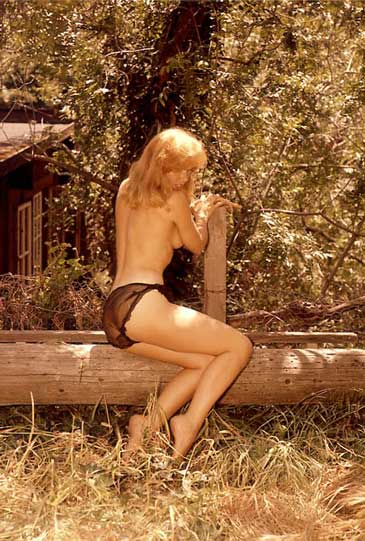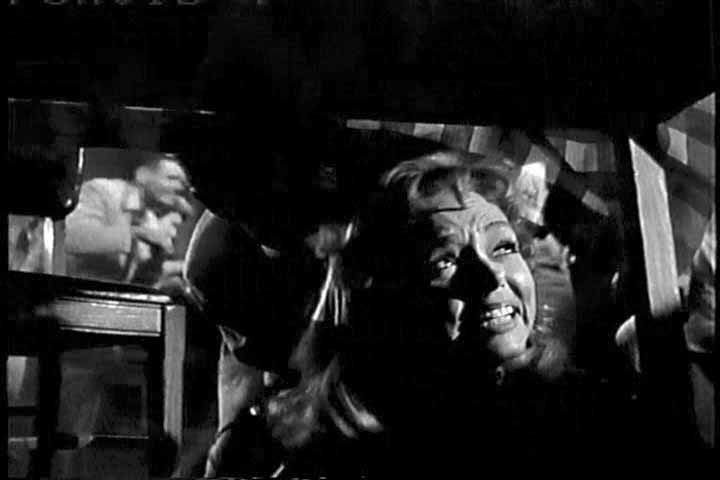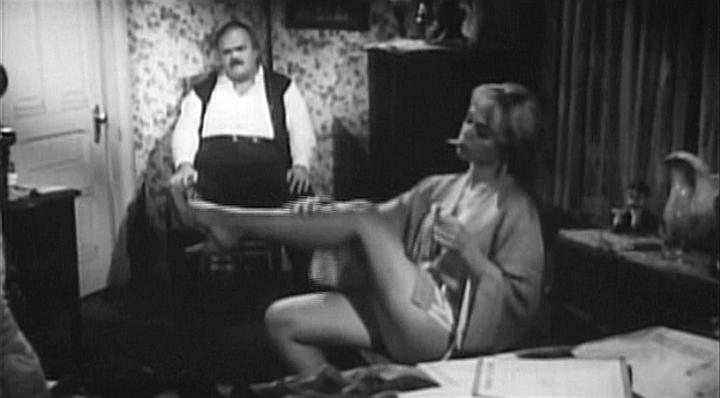Yvette Vickers as the Playboy Playmate of the Month, July 1959. Photographed by Russ Meyer.Queen of Scream
Yvette Vickers
August 26, 1928-April 27, 2011
Although her role in Sunset Boulevard was a minor, uncredited part, when details of Yvette Vickers’s secluded life emerged following the discovery of the 1950s scream queen’s mummified remains in her home on Cielo Drive in Los Angeles on April 27, it appeared her later years were spent much like those of Norma Desmond, the faded, delusional silent screen star memorably portrayed by Gloria Swanson in Billy Wilder’s classic film--the exception being that when found, the 82-year-old Vickers had apparently been dead for possibly a year, her mail piling up and yellowing in her mailbox, her front door laced with spider webs, but no one taking notice of her disappearance.
Vickers had lived in her 1920s-era stone and wood home for decades, and it served as the background for some of her famous modeling pictures. But over time it had become dilapidated, exposed in some places to the elements. (Much was made in the mainstream media of Vickers’s home being down the street from the Tate-Polanski home where Charles Mansion’s minions went on their murderous rampage in 1969, but that house had been demolished and a new one built in its place in 1994.)
A fan’s tribute to Yvette Vickers. Posted at YouTube by Gatorrock747.Susan Savage, an actress, went to check on Vickers after noticing old letters and cobwebs in her elderly neighbor's mailbox.
"The letters seemed untouched and were starting to yellow," Savage told reporters. "I just had a bad feeling."
After pushing open a barricaded front gate and scaling a hillside, Savage peered through a broken window with another piece of glass taped over the hole. She decided to enter the house after seeing a shock of blond hair, which turned out to be a wig. Inside the home, described by Savage as being in a state of extreme disrepair and piled with boxes containing clothing and mail, a space heater was still running in an upstairs room. She saw Vickers’s body on the floor but could not recognize it in its mummified state--her memories of Vickers are of a woman who sported a broad straw hat over her flowing blonde hair, favored white clothing and always had “a warm smile” on her face.
"She kept to herself, had friends and seemed like a very independent spirit," Savage says. "To the end she still got cards and letter from all over the world requesting photos and still wanting to be her friend."
Vickers was unattached in her later years. She was married and divorced twice, but her longest lasting relationship was an on-and-off 15-year affair with actor Jim Hutton (father of Timothy Hutton), who died in 1979.
The first ten minutes of Attack of the 50 Foot Woman, with Yvette Vickers coming on to married Harry Archer while his wife Nancy is being infected by an alien from outer space.In death, Yvette Vickers made more headlines than she ever made as an actress, but her demise also inspired a raft of Internet tributes to the woman for her indelible turns in ‘50s fright night monuments The Attack of the 50 Foot Woman and the Roger Corman-produced Attack of the Giant Leeches, in 1958 and 1959, respectively. Praise also came for her July 1959 Playboy Playmate of the Month centerfold, photographed by the immortal Russ Meyer, a man well suited toappreciate his model’s 35-22-35 measurements. Also of note: her first role following Sunset Boulevard was in James Cagney's first and only directorial effort, Short Cut to Hell, a remake of the 1942 Veronica Lake-Alan Ladd movie This Gun For Hire.
After 1959 Vickers’s film career diminished to a series of small roles in movies periodically between 1962 and 1991 (when she made her last screen appearance in the horror movie Evil Spirits). She appeared, briefly, in Pressure Point (1962; with Bobby Darin), and as a yoga girl in Beach Party (1963; with Frankie Avalon and Annette Funicello), and had a memorable scene with Paul Newman in Hud, director Martin Ritt’s acclaimed 1963 adaptation Larry McMurtry’s novel Horseman, Pass By. In 1971, she appeared in the Shelley Winters horror vehicle What's the Matter with Helen? In addition to films, Vickers made a number of appearances on popular TV shows of the era, including Bat Masterson, Dragnet, I Led Three Lives and The Rebel. She was more successful outside of show business, as a real estate agent, a career she embarked on in the 1970s. She also tried singing, releasing a jazz album in tribute to her parents, A Tribute to Charlie and Maria. For the 2007 DVD release of Attack of the 50 Foot Woman she contributed audio commentary.
Vickers may not have gone quietly into that good night, though. In the days following her death, suspicions of foul play surfaced, thanks primarily to the website Canyon News, where a confidante of Vickers, author and Hollywood historian John O’Dowd, claimed to have evidence pointing to something more sinister than the lonely death of a reclusive 1950s B-movie horror film star.
As reported in Canyon News by the site’s editor, Tommy Garrett:
…she feared several men, who she believed were stalking her and would cause harm to her.
O'Dowd shared with me chilling letters, which I am now in possession of, and they are very explicit in naming several men, she believed were stalking and threatening her. During my investigation, O'Dowd happened upon an audio tape that he'd received as part of an interview from Vickers. However, Side B was not erased as he'd earlier thought, and there are dozens if not hundreds of telephone hang-ups on the tape, part of what the star was complaining about in her letters and conversations to the bestselling author of Kiss Tomorrow Goodbye: The Barbara Payton Story.
Excerpts from some of Vickers's letters to John O'Dowd include the following statements: "[Redacted name] is more than an adversary, he is my enemy...Things are better now since the Bel Air patrol and the B.H. [Beverly Hills] Police are on watch." In another letter Vickers speaks of being gossiped about. "It amazes me how even smart people believe gossip ala [Redacted names]. In Hollywood they say if you want a friend, you get a dog! So, I did."
Author O'Dowd told Canyon News exclusively, "I know for a fact that, in the past, she feared for her safety. I have some handwritten faxes she sent me, dated as far back as March and April of 2003, in which she mentions that she was then receiving (in her words), 'a lot of hang-up calls, odd messages, and suspect cars [outside her house].' In one of the faxes she even mentions someone by name that she said was 'more than an adversary. He is clearly an enemy to me.'"
O'Dowd continued, "In our past phone conversations, Yvette sometimes mentioned a few industry people by name whom she feared. She said these people, all of them male, hated her and that she knew they were spreading lies about her in town. I lost touch with Yvette about three years ago (it was entirely my fault, and I really regret it now), but even at that time she sometimes spoke of not feeling safe in her home."
Yvette Vickers in Attack of the Giant Leeches (1959)Canyon News further reported that Ed Winter, assistant chief of investigation the Los Angeles Coroner's Office, is in touch with Vickers’s relatives in hopes of finding dental records or any other proof of identity “because at this point we are still trying to verify and identify the body to be that of Yvette Vickers. Obviously everything points to that, but we must do our job. We will do DNA testing of course, but this may take a while, since the body was found in the mummified condition and there are no immediate medical records. It will be a while before we make a statement about the cause of death as well."
Born Yvette Vedder in Kansas City, Missouri, on August 26, 1936, Vickers matriculated to UCLA after high school, where she majored in journalism. On a lark, she took an acting class, enjoyed it and changed her major to drama. While still a UCLA student she began appearing in commercials. She moved to New York to become the White Rain Girl in TV commercials, but soon returned to California hoping to break into films.
After Sunset Boulevard and Short Cut to Hell, she landed her first big part, co-starring with Allison Hayes in Attack of the 50 Foot Woman. As portrayed in the movie, Vickers’s Honey Parker is a floozy who pays dearly for her flings with a married man, one Harry Archer (played by William Hudson), while Archer’s wife Nancy (Hayes) is being terrorized, and infected, by a giant alient she encounters while speeding along a deserted highway late at night. Because Nancy has a drinking problem, no one believes her tale, and her doctor administers a sedative to calm her down. Harry then tries to do her in with a lethal injection of his own, only to find that instead of killing her, it has caused her to grow to gigantic proportions. She keeps on growing. Fifty feet tall and very angry, she stalks the earth, growling “Harry! Harry!” and seeking retribution for his betrayals. Honey Parker is in her sights too, you bet--the behemoth Nancy tracks her down to a bar and tears the roof off the joint, loosening a beam that then falls on and sends Honey to the promised land. Nancy is eventually brought down when a stray shot from the sheriff accidentally hits a power line transformer, causing an explosion that kills Nancy, in whose outsized hand lies the crushed figure of husband Harry.
Yvette Vickers awaits her fate at the hands of the behemoth Nancy Archer in Attack of the 50 Foot Woman (1958)Her next role came in Roger Corman’s Attack of the Giant Leeches (aka The Giant Leeches), described by one critics as “another of the poverty-row creature features produced by Roger Corman, in this case with an assist from brother Gene Corman, in the back end of the fifties before his popular cycle of Edgar Allan Poe adaptations began.” In this case, a community near a Florida game preserve is attacked by leeches that have grown to enormous proportions after being exposed to atomic contamination from nearby Cape Canaveral. The town sheriff, a wildlife preservation specialist and a local doctor team up to try to dispath the ravenous, outsized creatures in a little more than an hour’s running time.
Yvette Vickers in Attack of the Giant Leeches: ‘The biggest draw among the cast is definitely Yvette Vickers, who has little to do but show off her physical charms.’As Kevin Pyrtle recounts in his review of the film at WTF-FILM, “Its novel menace and a few scare scenes aside, Attack of the Giant Leeches is a pretty dull affair hampered greatly by a paltry screenplay by Leo Gordon (The Wasp Woman). A sleazy white-trash love triangle between sexy Yvette Vickers and her two beaus--a fat husband and a local miscreant--is good for laughs, but the rest is strictly by the books. There's some forced irony to our wildlife preservation specialist hero's realization that not all animals are worth saving. He ultimately dynamites the leeches' swamp home after an hour of rallying against it on ethical grounds.
“Performances are a mixed bag. Lead Ken Clark makes for a thoroughly uninteresting hero while veteran bit actor Gene Roth (Zombies of Mora Tau) is wasted in his paltry role as the town sheriff. Roth seems to have made quite a living in small roles, with over 250 to his credit. The biggest draw among the cast is definitely Yvette Vickers (Attack of the 50 Foot Woman), who has little to do but show off her physical charms.”
Concludes Pyrtle: “This one is worth at least one trod through if only for a few moments of creepiness and Yvette Vickers' legs. Those for whom these simple pleasures are not enough should probably steer clear.”
Yvette Vickers and Paul Newman, Hud (1963)In the Canyon News article cited above, John O’Dowd offered an insight into Vickers that escaped other reporters, who seized on the tragic recluse theme as the sum and substance of the actress’s life story or as some kind of object lesson about the treacheries of show business.
"Yvette had an incredible warmth that was very endearing,” O’Dowd says. “She was earthy and intelligent, funny and sweet, and very savvy about people. She also loved animals, as I do, and she was completely heartbroken when her longtime companion animal, her dog, Garbo, passed away about seven years ago. Yvette and I had several marathon phone conversations over the years where we talked about everything under the sun. She was very contemporary in her thinking (probably more so than me, in fact), and we shared a similar love of music. For instance, we both loved Guns N' Roses and Santana.”
An in-depth article on Vickers’s life and death is at the ABC News website.
Founder/Publisher/Editor: David McGee
Contributing Editors: Billy Altman, Laura Fissinger, Christopher Hill, Derk Richardson
Logo Design: John Mendelsohn (www.johnmendelsohn.com)
Website Design: Kieran McGee (www.kieranmcgee.com)
Staff Photographers: Audrey Harrod (Louisville, KY; www.flickr.com/audreyharrod), Alicia Zappier (New York)
E-mail: thebluegrassspecial@gmail.com
Mailing Address: David McGee, 201 W. 85 St.—5B, New York, NY 10024






